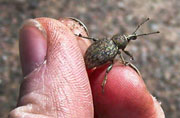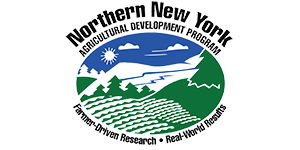
Dairies Cannot Afford to Ignore Alfalfa Snout Beetle,
Even in Low Milk Price Cycle
Northern NY: June 5, 2018. Untreated, alfalfa snout beetle is costing Northern New York farmers with 100-cow dairies between $30,000 to $60,000 per year every year, depending on the size of the pest infestation and the speed of alfalfa stand loss.
The current cost of controlling alfalfa snout beetle with biocontrol nematodes in a single application for multi-year control is $28 per acre plus the cost of application by the farmer or a custom service.

“Even with the terrible milk prices farmers are currently facing, the cost of biocontrol nematode application should be weighed against the cost of not protecting your alfalfa crop,” says Dr. Elson Shields, the Cornell University entomologist who pioneered the biocontrol nematode solution to combat alfalfa snout beetle and that now appears to be useful for protecting other crops
With assistance from Ev Thomas, Oak Point Agronomics, Ltd; Mike Hunter, Cornell Cooperative Extension; Tom Kilcer, Advanced Ag Systems, LLC; and Michael Miller, W.H. Miner Agricultural Research Institute, Shields and Research Support Specialist Antonio Testa estimate the true cost of alfalfa snout beetle moving onto the farm in three distinct areas:
- alfalfa stand and yield loss: average $325 per acre (per cow) per year; range: $200-$500 depending on speed of loss of stand
- expense of off-farm protein purchased to replace forage quality of lost alfalfa crop; for example, extra soy costs: average $120 per cow per year; range: $56.40 -$201; plus
- the resulting impact on farm CAFO plan from increased phosphorus brought on farm with increased purchases of protein-like soybean meal.
When a nematode-treated alfalfa field is rotated into corn, research has shown a positive impact on reducing wireworms and corn rootworm. After 4 years of corn production, research has shown that the biocontrol nematodes remain in the field at sufficient populations to provide continual control of alfalfa snout beetle.
Biocontrol nematode applications must be made before September 15. Best results are obtained by applying to alfalfa fields in their seeding year or first production year. It requires 3 to 5 years to totally inoculate a farm with nematodes to reduce the snout beetle population to a manageable level. Learn more at www.alfalfasnoutbeetle.org.
 A long-term research commitment by the farmer-driven Northern New York Agricultural Development Program supported the development of the science needed to pioneer the use of native nematodes, tiny insect-attacking worms, as a biocontrol to suppress the spread of alfalfa snout beetle.
A long-term research commitment by the farmer-driven Northern New York Agricultural Development Program supported the development of the science needed to pioneer the use of native nematodes, tiny insect-attacking worms, as a biocontrol to suppress the spread of alfalfa snout beetle.
Subsequent research funded by the Northern New York Agricultural Development Program, New York Farm Viability Institute, and others is showing application of the biocontrol nematodes for controlling berry pests, white grub, and other crop pests in New York State and elsewhere in the U.S.
Funding for the Northern New York Agricultural Development Program is supported by the New York State Senate and administered by the New York State Department of Agriculture and Markets. Learn more at www.nnyagdev.org.
MORE INFORMATION: from Cornell University and collaborators
Increased Feeding Costs Due to High Quality Forage Loss to Alfalfa Snout Beetle
With the assistance of Ev Thomas, Oak Point Agronomics, Ltd., and Michael Miller, W.H. Miner Agricultural Research Institute, the Cornell Department of Entomology has estimated the cost of soybean meal to replace the lost alfalfa in a diet of 30 percent forage and 70 percent corn in various scenarios as follow.
Situation 1: Clear-seeded alfalfa lost, replaced to high quality grass (15% CP)
Extra Soy Cost in Diet = $9.30 per cow per month ($111.60 per cow per year); 100 cows = $930 per month or $11,160 per year.
Situation 2: 50% alfalfa, alfalfa is replaced with high quality grass (15% CP)
Extra Soy Cost in Diet = $4.70 per cow per month ($56.40 per cow per year); 100 cows = $470 per month or $4,230 per year. 5640
Situation 3: Clear-seeded alfalfa lost, replaced to average quality grass (11% CP)
Extra Soy Cost in Diet = $16.80 per cow per month ($201 per cow per year); 100 cows = $2,010 per month or $20,100 per year.
Situation 4: 50% alfalfa, alfalfa replaced with average quality grass (11% CP)
Extra Soy Cost in Diet = $8.40 per cow per month ($100.80 per cow per year); 100 cows = $840 per month or $10,080 per year.
A middle of the road figure would be $10 per cow per month ($120 per cow per year) and 100 cows = $1,000 per cow per month ($10,000 per year) (range $5,640 – $20,100 per 100 cows per year).
This brings the cost of alfalfa snout beetle on the farm to $445 per cow per year every year, not accounting for the impact on the CAFO plan for the dairy:
Stand and Yield Loss: $325 per acre (per cow) per year, range: $200-$500
Extra Soy costs: $120 per cow per year, range: $56.40-$201
Total: $445 per cow per year every year; 100 cows = $44,500, range $30,000-$60,000
The Cost of Stand Loss from Alfalfa Snout Beetle Damage
With the assistance of Ev Thomas, Oak Point Agronomics, Ltd; Mike Hunter, Cornell Cooperative Extension; and Tom Kilcer, Advanced Ag Systems, LLC, the Cornell Department of Entomology estimated that alfalfa stand loss from alfalfa snout beetle cost the farmer between $200-$400 an acre per year in a three-cut, 4-year rotation system and $200-$500 per acre per year in a 4-cut, 3-year rotation system. The cost figure is a combination of establishment costs, loss of yield, and fixed land costs.
The variation in cost is dependent on the speed of stand elimination by alfalfa snout beetle. If the stand is eliminated in a single year, the higher cost is appropriate and if the stand is eliminated over 2-3 years, the lower cost is appropriate. A middle of the road figure would be $325 per acre per year. Using the rule of thumb that one acre of forage feeds a cow for a year, stand losses from alfalfa snout beetle equals $325 per cow per year.